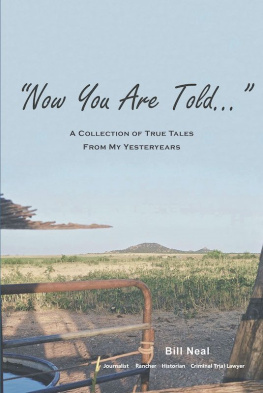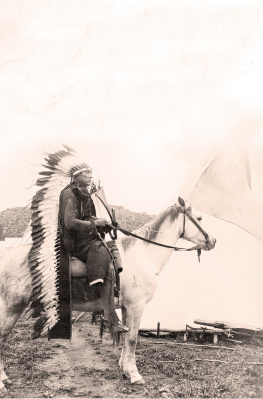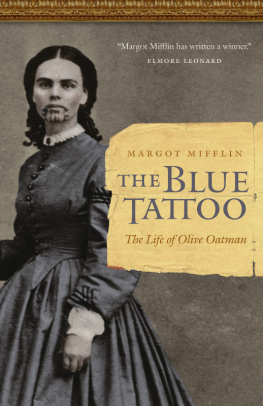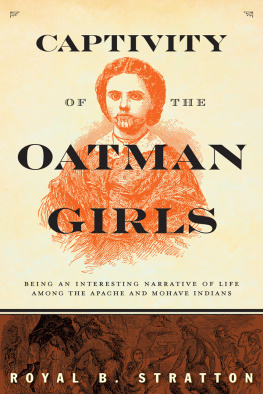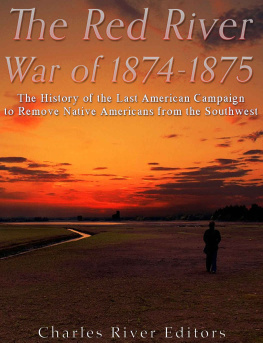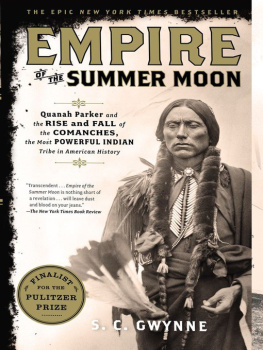Contents
Guide

For information on the white Indians that could not be obtained from public archives, I relied heavily on the kindness of strangers, many of whom became my friends and regular correspondents. I am deeply indebted to these genealogists, fellow researchers, and descendants of the individual captives whose lives I followed:
Dot and Banc Babb: Eugene T. Babb, Leslie Hargus, Anna Crooks, Daniel Crooks, Claudia Crooks, Roy Slonaker, Bette S. Anderson, Roslyn Shelton, Bill Lynch, Debby McClintock, Carol Schmitt, Marca Kent, Lydia Tilbury Hair, Marcy George, Claud Elsom Jr., and Molly Culver.
Minnie Caudle: Damon W. Benson, Neoma Benson Cain, Frank Modgling, Johnie Lee Reeves, Wayne Benson, Dave Johnson, Debbie Modgling Rieger, Janine Modgling, Kathleen Burns, Jodie H. Benson, Audrey Vodehnal, Christopher H. Wynkoop, and Cindy Gettelfinger.
Rudolph Fischer: Josephine and Edward Wapp, Teresa Parker, Lorene Kerchee Pewe-wardy, Betty Crocker, Kenn Knopp, and Sallie Tonips.
Temple Friend: William A. Hadwiger, Tom W. Locke, and Tom Kingery.
Adolph Korn: Lela Korn Hennigh, Jerry Korn, Gene Zesch, Lora Hey, Susie Ellison, Peggy Laverty, Patty Moss, Max Hey, Ron Sheets, Patricia McCrory, Johnita Bohmfalk, Al Dreyer, Neil Fisher, Gerald Geistweidt, Delvin Bauer, and Gerry Gamel.
Herman Lehmann: Gerda Lehmann Kothmann, Esther Lehmann, Vanessa Burzyn-ski, Buzzy Parker, Carlos Parker, and Don Dye.
Clinton and Jeff Smith: Edda Raye Smith Moody, Carlene and Tom Smith, Beth and Allen Smith Jr., Clint and Nettie Smith, Kay Dean, Emmett Buddy Smith, C. L. Smith, Joe and Molly Butcher, Jerome Janca, and many other family members who welcomed me at the Smith reunion.
For information on other individual characters in the story: Sarah Franklin, Elizabeth Mahill, Billy Markland, Sam Oatman, Kay Reichenau Ponder, Anita Sanders, and Bobby Wadsworth.
The following staff members and volunteers at research centers patiently and cheerfully responded to my requests for information, often steering me toward sources I otherwise would not have found:
Towana Spivey, Ramona East, and Jo Ruffin, Fort Sill Museum Archives, Fort Sill, Oklahoma;
Deborah A. Baroff, Museum of the Great Plains, Lawton, Oklahoma;
Kristina Southwell, Josh Clough, and John R. Lovett, Western History Collections, The University of Oklahoma Libraries, Norman, Oklahoma;
William D. Welge, Chester Cowen, Bill Moore, Oleta Kite, Tressie Nealy, Lillie Kerr, and Phyllis Adams, Oklahoma Historical Society, Oklahoma City, Oklahoma;
Jill Abraham, George Briscoe, Richard Fusick, and Mary Frances Morrow, National Archives and Records Administration, Washington, D.C.;
Rodney Krajca, National Archives and Records Administration, Southwest Region, Fort Worth, Texas;
Dulcinea R. Almager and Betty L. Bustos, Panhandle-Plains Historical Museum, Canyon, Texas;
Jim Bradshaw, Norma Thurman, and Nancy Jordan, Nita Stewart Haley Memorial Library, Midland, Texas;
George Elmore, Gia Lane, and George Butler, Fort Larned National Historic Site, Larned, Kansas;
Mark Vargas, Mitzi Kay Cook, and Dianne Carroll, University of Science and Arts of Oklahoma, Chickasha, Oklahoma;
Robert S. Cox and Valerie-Anne Lutz, American Philosophical Society, Philadelphia, Pennsylvania;
Susan McElrath, Smithsonian Institution National Anthropological Archives, Suitland, Maryland;
Jane Hoerster, Julius DeVos, Wanda Hitzfelder, Robert and Linda Laury, and Jerry Ponder, Mason County Historical Commission, Mason, Texas;
Mary Jo Cockrell, Heartsill Young, Theresia Schrampfer, and Janice Walters, M. Beven Eckert Memorial Library, Mason, Texas;
Beatrice Langehennig, Mason County and District Clerk, Mason, Texas;
Frederica Burt Wyatt, Kimble County Historical Commission, Junction, Texas;
Becky Matticks, Edith Williams, and Anna Louise Borger, Butler County Historical Society, El Dorado, Kansas;
Rosalie Gregg, Carla Womack, and Shirley Zedaker, Wise County Heritage Museum, Decatur, Texas;
Paul Follett and Mary Lou Gorthy, Lawton Public Library, Lawton, Oklahoma;
Rob Groman and Gayle Brown, Amarillo Public Library, Amarillo, Texas;
Sue Steiner, Reedsburg Public Library, Reedsburg, Wisconsin;
Peter Shrake and Mary Farrell-Stieve, Sauk County Historical Society, Bara-boo, Wisconsin;
Alice Laforet, Fredericksburg Genealogical Society, Fredericksburg, Texas;
Richard Himmel, Morris Martin, Mary Durio, and Cynthia Beard, Willis Library, University of North Texas, Denton, Texas;
Andrew Jelen, Wichita Falls Public Library, Wichita Falls, Texas;
John M. Cahoon, Seaver Center for Western History Research at the Natural History Museum of Los Angeles County, Los Angeles, California;
Martha Utterback, Daughters of the Republic of Texas Library, San Antonio, Texas;
Paul Camfield, Gillespie County Historical Society, Fredericksburg, Texas;
And the many knowledgeable librarians and archivists who assisted me at the Center for American History at the University of Texas at Austin; San Antonio Public Library; Texas State Archives; New York Public Library; the Library of Congress; Kansas State Historical Society; Fort Concho Museum Library; Southwest Collection at Texas Tech University; University Library at the University of Texas at El Paso; National Archives and Records Administration at College Park, Maryland; Dallas Public Library; Houston Public Library; Charles E. Young Research Library at the University of California at Los Angeles; Llano Public Library in Llano, Texas; Pioneer Memorial Library in Fredericksburg, Texas; and Chico Public Library in Chico, Texas.
For insight into the Comanche way of life, I extend my warmest thanks to Barbara and Ken Goodin, Dan Gelo, Tom Kavanagh, Vernon Cable, Larry Liles, Billie Cable Kreger, Ron Red Elk, the elders of the Comanche Language and Cultural Preservation Committee, and the members of the Petarsy Indian Methodist Church.
For access to several privately owned sites described in the story, I am grateful to John and Joyce Haynes, Mike Haynes, Estella Hoerster, Dorothy and John Harold Schuessler, Anthony and Gloria Nebgen, Edgar James Moss, and Bill Knox.
My good friends Steve Adams and Mary Cook invested a great deal of time meticulously reading my first draft, and the finished product is much better as a result of their wise observations and suggestions.
A host of supportive relatives, friends, and fellow historians and writers provided me with overnight accommodations, work space, meals, leads, opinions, keen readers eyes, and good company while I was working on this book, among them Jerialice Arsenault, Darlene Bryand, Marc Castle, Chan Chandler, Anne Dempsey, Jane Dentinger, David and Mary Dreyfus, Karl Field and Mary Jordan, Glenn Hadeler, Matt Hey, Alan C. Huffines, Jo Ann Hughen, Sam and Jun Hurt, Jamie Smith Jackson, Tom and Janet Jones, Misha Jordan, Quentin Jordan, Terry Jordan, Katye Kowierschke, Louise Larson, Peggy and Bill Laverty, Laura Lewis, Matt Loy-nachan, Bill and Modena Marschall, John McEwan, Fran and Skeeter Merritt, Greg Michno, Karen and Greg Mitchell, David Murray, Steve Mustoe and Rhonda Stoltz, Dean, Kim, and Austin Nolan, George Ward, Susan and Tanner Weil, Norman Weiss, Jackie Wertheimer, Casey and Lucinda Zesch, and Gene and Patsy Zesch.
The Captured was transformed from manuscript to book through the diligent efforts and creativity of Meryl Gross (production editor), Michelle McMillian and Deborah Kerner (designers), Cathy Turiano (production manager) David Cain (cartographer), Deborah Miller (copy editor), and Liz Catalano (proofreader).


